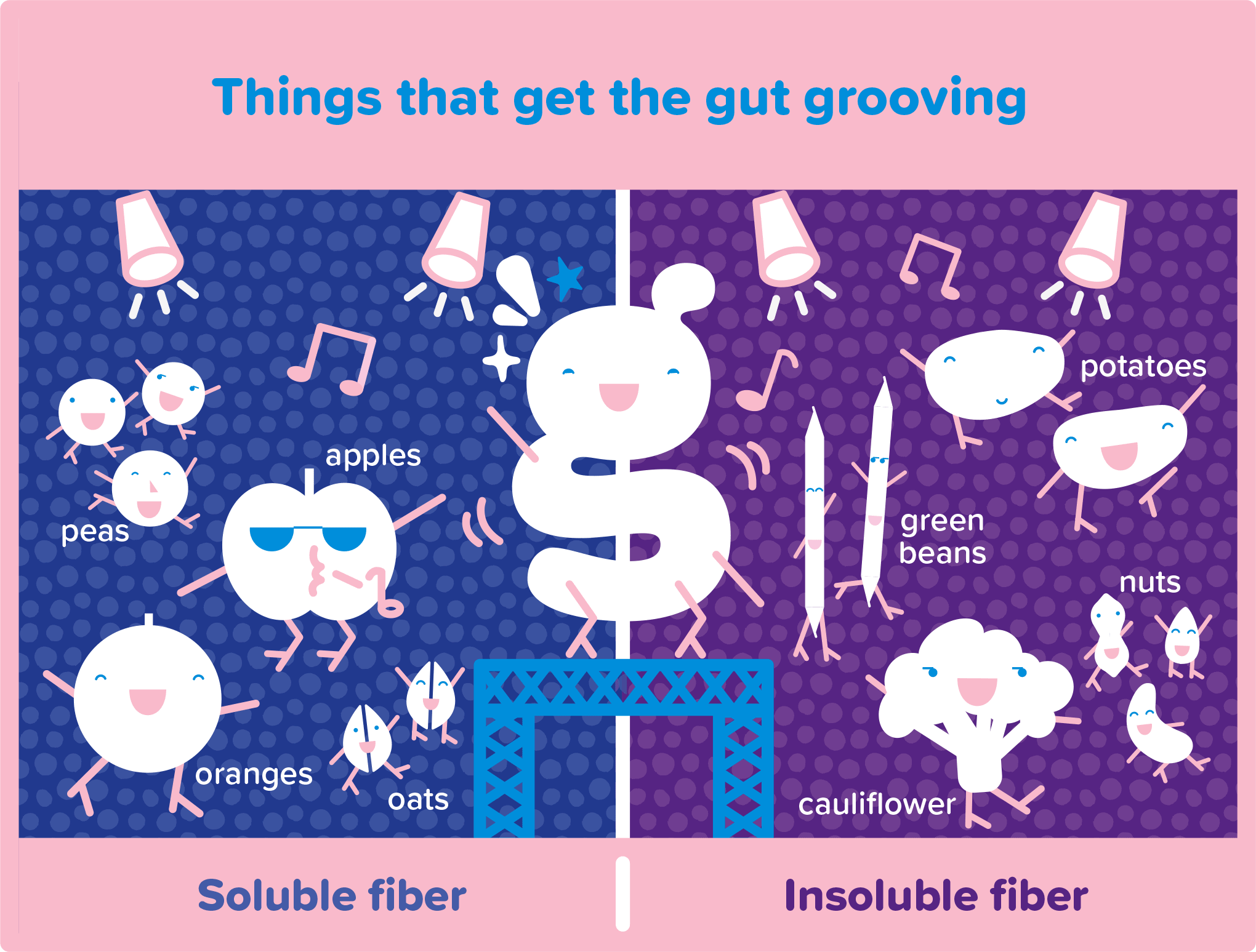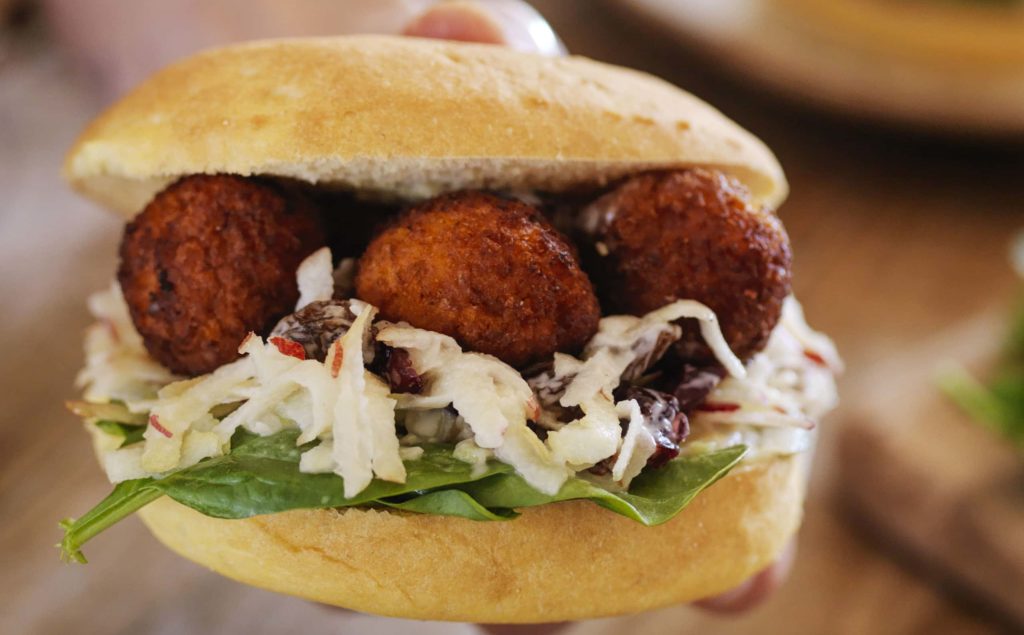You might have heard that fibre is good for the gut, a digestive wellness champion or a brilliant bowel movement kick starter. It’s even considered to be a super food – super by name, super by nature.
First things first, what is fibre?
Fibre is a type of carbohydrate that cannot be broken down by our digestive system no matter how hard it tries. And this is fibre’s secret to success. As we can’t break fibre down, it reaches our large intestine (also known as the colon) intact. Whilst it isn’t feeding us so to speak, it remains on the menu for our trillions of gut bacteria which is great news (more on this later).
So why do we need fibre?
When it comes to health, fat and sugar are always grabbing the national headlines but fibre is rarely front page news. With less press, perhaps you’re confused as to why we need fibre in our diet. After all, if we don’t digest it, how can it benefit us?
It works in different ways to look after our bowel and overall health. Let’s take a deeper dive into the two types and functions of fibre to help us.
Soluble & insoluble fibre
Fibre can either dissolve in water (soluble) or can’t (insoluble) and these different characteristics help our guts to get grooving. Soluble fibre softens our poo whilst insoluble fibre increases the bulk of it. Working together they keep our bowels healthy by moving things along quickly, helping us ‘go’ more often and prevent constipation. This is a key function of fibre and a super important reason to include lots of it in our diets!

What does fibre do apart from keeping our bowels moving?
We have looked at what fibre is but what else can it help with? Whilst we aren’t the ones breaking it down, the trillions of bacteria and other microbes in our guts feast on fibre – a process known as fermentation. The same process that turns cabbage into sauerkraut or grapes into wine!
As the fibre is broken down, it produces awesome nutrients such as helpful fatty acids and vitamin K. These nutrients protect our gut wall, improve our immune system, defend us from infections and keep bad bacteria at bay. How very clever, Genius you could say…
Are there any other long term benefits of fibre?
Absolutely! As if feeding our good bacteria wasn’t enough, eating a gut lovin’ diet full of fibre has loads of benefits according to the World Health Organisation1. It reduces the risk of heart disease, certain cancers, and type 2 diabetes. Fibre has also been shown to help keep weight under control and lower cholesterol levels.
What is the fuss about prebiotic fibres?
Some fibres are more fermentable than others – in other words there are certain types of fibre that bacteria prefer to eat. These are known as prebiotic fibres. Prebiotics support our healthy bacteria (probiotics) to thrive, both in amount and type. Just like a well-fertilised lawn grows green and thick, we want our helpful gut bacteria to do the same by feeding them the right stuff.
That’s why here at Genius we’ve ensured our recipes are not only high in fibre but have a portion of prebiotic fibre too. Your gut bacteria will love you for it.
Getting started – 10 top tips to eat more fibre
1. Start at breakfast
Breakfast seems like a sensible place to start if you’re thinking about how to create some high fibre meals, right? Porridge can contain gluten free wholegrains (when its made with certified gluten free oats) and is brimming with soluble fibre – the type that helps to keep our cholesterol levels down. You can also boost fibre in your porridge or muesli by sprinkling nuts, seeds or dried fruit across the top. We love flax, hemp and chia seeds and we go nuts for walnuts, pecans and pistachios. If you’re not a cereal fan, don’t worry, our breads are high in fibre with Genius Triple Seeded Farmhouse providing 6g fibre per serving, wow!
2. Frozen veg
A simple win when it comes to creating fibre packed meals is to boost the number of veggies you use. Recipes may suggest vegetables that go well with that particular dish, but really there are no rules! Throw in whatever veg you like, the more the merrier… Being flexible helps to avoid wastage and you might find some cracking combinations in the process. Frozen veg are fabulous, especially when vegetables become more expensive out of season. Soups are a really hearty way of increasing veg and pulse intakes – a bowl of our tomato and bean soup for example contains an amazing 5 portions. Delicious!
3. Fruit smoothies
Try blending lots of fruits together to make a scrummy smoothie. Add a dash of juice or milk (dairy free if you’d like) to make it extra smooth. Frozen fruit can be added straight from the freezer so you don’t need to worry about having fresh fruit at home. If you like your smoothies vibrant and green, you can add some veggies in there too, such as avocado. This gives a lovely creamy texture. You can also boost the fibre and protein content of smoothies by adding ingredients like oats or nut butters. Smoothies aren’t just a breakfast choice – you could have them after exercise or between meals as a high fibre snack. Here’s a genius tip – portion out smoothie ingredients and freeze daily amounts in re-usable tubs or bags. The prep and hard work is now done and all you need to do is grab one and blitz it up!

4. Swap your snacks
Snacking is something we all love doing, especially when life is busy and we’re here, there and everywhere. Imagine how much our guts would love us if we made sure our snacks were bursting with fibre! Really easy high fibre snacks include fruit, nuts and popcorn. Also look out for pulse-based snacks in stores, from flavoured chickpeas to roasted broad beans and little pots of edamame, they will fill the snack bowl with less fat and even more fibre than nuts. Cereal bars with these ingredients can also provide a convenient, on-the-go high fibre snack.
5. Check the claims
Insider knowledge here: if a ready-made product makes a high fibre claim, it will be giving you at least 20% of your recommended 28g a day 6g per serve. The Genius range hits or exceeds this. Check it out on pack!
6. Easy reach fruit bowl
We’ve discussed the smoothie but what about the fruit bowl? Pop it somewhere obvious and somewhere you pass often throughout the day to encourage you to eat more! Don’t be afraid to throw some veg in the fruit bowl too as if it is hidden away in the fridge, we are likely to eat less. Cherry tomatoes, sugar snap peas and carrots all sit nicely in the fruit bowl and can be grabbed as you pass. A gut friendly snack doubled up as quirky art sounds brilliant to us.
7. Meal prep veg
With a little more time, chop a load of veggie sticks and keep them in a sealed container for use during the week. They go really well with dips too which have been shown to boost veg intakes in children. Take delicious hummus, salsa or guacamole for example. If you can prepare some veg in bulk it will help to keep fibre intakes up, even when your week gets busy and prep for meals has to be super quick! They can also be frozen, deja vu back to tip number two. Scrubbing root veg and leaving skins on will boost your fibre too and saves the need for peeling – win win!
8. Easy bread swap
We’re a nation of sandwich lovers with chicken being one of our top fillings. There are easy ways to jazz up this staple to boost our fibre intake. Genius bread and rolls contain twice the fibre of many wheat-based bread and rolls. Adding some salad into every sandwich creates a high fibre meal and a whole lot of colour too. Take a look at our Butternut Squash falafel with fruity slaw bun for example, it’s beautiful!

9. Gluten free grains
High fibre meals can be created with plenty of veg and choosing a wholegrain will help too. Brown rice, quinoa and buckwheat noodles are naturally gluten free wholegrains, and they are yummy! Swapping rice noodles for soba noodles is another great little boost of fibre.
10. Beans, pulses and lentils
We are big fans of beans, pulses and lentils. They are such a versatile source of protein and fibre but best of all, they are really cheap too! Canned beans or chickpeas can be added to many of your favourite dishes, for example lasagne, chilli, casseroles or even sausage and mash. They don’t require any preparation, just a quick drain and rinse. Lentils come dried or canned. If you’re not sure if pulses are for you then start slow, substitute half of the meat in a dish to start with and take it from there. Before you know it they’ll be a staple in your food shop.
We’ve put it on a plate for you (quite literally!) by innovating super tasty simple swaps to help fibre seamlessly fit into your life; our bread, wraps and rolls, to name a few, are wonderful staples for everyday meals. There’s plenty of high fibre and gut lovin’ recipes here that will help you get even closer to that 30g target.
1. https://www.thelancet.com/journals/lancet/article/PIIS0140-6736(18)31809-9/fulltext
